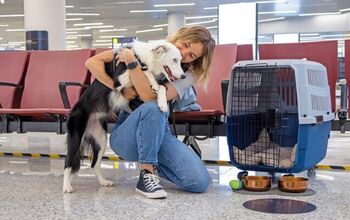Ask the Animal Communicator: Why Does My Dog Bark So Much?

Barking. Even if you are a lifelong dog lover, the sound of your pup barking nonstop can seriously get to you after a while. Why do some dogs bark so much? Is your dog really trying to tell you something or are they just the canine equivalent of a nonstop talker? When you’ve tried everything to silence the furry barker in your household and nothing works, it is time to ask the animal communicator for help!
Dear Shannon,
I just adopted a mixed breed rescue pup. Sandra is 6 years old. She is the sweetest – truly, she loves to cuddle with me and be petted and she follows me around everywhere. But I won’t lie. There is one thing she does that has me losing my patience and that is her barking. She barks at everything. And nothing. Sometimes she starts barking and I go out to see what is wrong and literally she is just sitting in the middle of the floor barking at nothing and no one. I’m at my wit’s end. I really don’t want to relinquish her but she is so loud and nonstop my neighbors are starting to complain. Can you help?
Thanks,
Brett (who needs the barking to stop)
Shannon’s reply:
Hi Brett,
Your question is one of the most common questions I hear in my line of work. Dog barking can be challenging enough to deal with when it is occasional or coming from the neighbor’s house. When it is constant and coming from your own house, and nothing you try makes it stop, well, I don’t blame you for being at your wit’s end!
Luckily, you’ve reached out to an animal communicator. What does that mean? I’m not a pet trainer or an animal behaviorist. Rather, I have access to a different set of language skills to communicate across species boundaries. To make a long story short, I can ask Sandra questions, receive her replies and share them with you.
When I reached out to Sandra to ask her about her barking behaviors, she had some very specific feedback to share with me that I think will help you a lot in resolving this situation.
The first thing Sandra shared with me is some information about her past before she met you. Her first owner had several dogs and left them all out in the yard for days at a time. Often they didn’t have enough food or water and they never knew when they would get more of either. When a neighbor finally reported the owner to the police, the shelter intervened, and Sandra was rescued. But the shelter was overcrowded and once again her care was intermittent. The only way she could get anyone’s attention was to bark and bark and bark.
When she came to you, she was so grateful to find a kind human who wanted her! But she still feels so traumatized – as anyone would after never knowing if they will have enough to eat or drink from one day to the next. And all she knows to do to keep in contact with you is to bark. This is especially true if you leave the room, and she can’t see you. She barks to call you back to her.
It probably won’t surprise you to learn that I feel the energetic signature of both trauma and anxiety when I tune in with Sandra. She needs help to let go of her painful past and recalibrate her fight-flight-freeze emergency response system to her safe, calm, and kind new home life with you.
So how can we help Sandra calm down and begin to trust that she doesn’t need to bark all the time to make sure you are aware she is there and has needs?
I have a few recommendations that have helped many of my pet clients who suffer from anxiety, trauma, and PTSD symptoms.
The first resource I want to offer is called EFT tapping, or Emotional Freedom Technique. EFT was developed to assist returning active-duty combat personnel with severe post-traumatic stress disorder (PTSD) symptoms. The same EFT sequences that work so well for people can be easily adapted for pets and they work just as well. You can find a free guided series on how to do EFT for pets on my website (link in bio).
I also want to recommend using essential oils with Sandra in a very specific way that allows her to choose what essences she needs. This is called zoopharmacognosy, a word that describes what wild animals often do when they have a specific need such as to protect their den from pests or to treat an open wound to keep it from festering. Our companion animals don’t have the luxury of going out into the wild to forage for what they need, so we must bring the options to them.
I am not an aromatherapist, so please do seek out a qualified practitioner for customized guidance. However, here are a few tips that will at least give you a place to start.
For Sandra, I would start off with a few vials of known calming essential oils such as chamomile and lavender. Make sure the oils are organic and certified pure. Hold the closed vial near Sandra and allow her to sniff it. Notice whether she turns towards the vial or away. Watch her eyes and her body language to see if she tenses and moves away or relaxes into calm. This will tell you which oil she resonates with.
Sandra also tells me that she is quiet sometimes. But then she tunes into you, and it feels like you are picturing her barking. She takes that as a sign to start barking again. This is a common feedback loop pets and their people can fall into without even realizing it.
So how do you fix it? Instead of using your thoughts, emotions, and mental pictures to reinforce the behavior you do want – a quiet dog – you are always waiting for the barking to start again. You are literally sending Sandra the message, using your mental pictures and emotions, to start doing the thing you don’t want her to do more of – bark! The more you can send Sandra the emotional and visual cues to remain quiet and calm, the more she will begin to trust that she can stay quiet and still get her needs met.
Brett, I hope these tips are helpful to you. You are a rescue angel and Sandra is grateful to have a safe and comfortable home with you. There are many, many options for working with traumatized dogs like Sandra and I want to commend you for leaving no stone unturned to help her feel safe and at ease in her new life with you.
From my heart,
Shannon

Shannon Cutts is an intuitive animal communicator and Reiki master practitioner with Animal Love Languages. Shannon works through the universal love language of all species to connect with her pet clients – deep listening. Deep listening activates empathy, allowing Shannon to literally feel what an animal is feeling, listen in to their thoughts, experience what they are experiencing and then relay all of that information to the pet parent. Visit Shannon at www.animallovelanguages.com
More by Shannon Cutts























